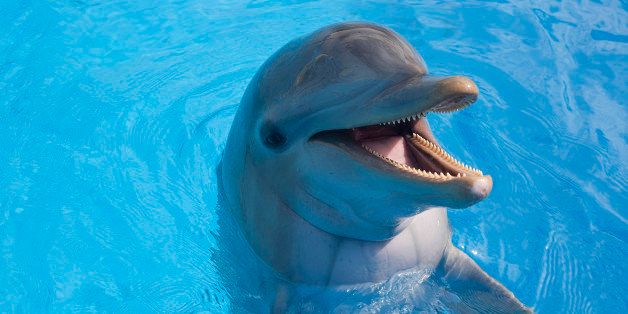
The National Aquarium announced Wednesday that it is considering no longer having dolphins on exhibit, putting the popular Inner Harbor attraction at the forefront of a debate over whether keeping the animals in captivity is cruel.
The aquarium is considering moving the eight mammals from the Dolphin Discovery amphitheater to an ocean-side sanctuary at an undetermined location. It has hired a team of consultants to examine the issue as part of a broader strategic assessment to ensure a "healthy future for the nonprofit institution and its animals."
"After 33 years, it's time," said John Racanelli, who runs the aquarium. "The era of modern aquariums began here in 1981, and a lot has changed.
"We know so much more today about the animals and about our evolving audience -- and frankly how urgent the need has become to protect the health of oceans and the Chesapeake Bay. As a conservation organization first and foremost, we have to evolve."
The aquarium is one of Baltimore's biggest tourist attractions with 1.3 million visitors a year.
As part of the assessment, called BLUEprint, the consultants also have been asked to consider how to reimagine the aquarium experience, whether the aquarium should establish an "ocean embassy" in Washington and what role aquariums should play in caring for animals and the environment.
No timeline has been set to conclude the evaluation, which the nonprofit characterized as ambitious and far-reaching. The assessment is expected to cost several hundred thousand dollars, Racanelli said.
Simply asking whether dolphins should be kept in captivity makes the National Aquarium more progressive than other aquatic attractions, said Lori Marino, an Emory University neuroscientist and research associate with the Smithsonian Institution.
"They should be applauded," said Marino, who has researched dolphin behavior and intelligence for two decades. "Other places make justification for why [dolphins] are in captivity, and they are asking the question: Should they be?
"They are responding to what we know scientifically, about how dolphins fare in captivity. Public opinion is starting to change."
Enclosed marine mammals, Marino said, show signs of immune system dysfunction from chronic stress and behavior abnormalities, such as repetitive nonsensical actions, increased aggression and self-mutilation. What's more, "there is really no evidence that these dolphin displays are educational in any way."
Marino said the CNN documentary "Blackfish," a controversial film about orcas in captivity and the killing of a Sea World trainer in 2010, helped to elevate the debate. She said aquatic attractions have put ticket sales ahead of the welfare of marine mammals such as dolphins, killer whales and belugas.
Leaving the aquarium Wednesday with her 18-month-old and 11-year-old daughters, Mindy Hopkins was surprised to learn that the aquarium is considering no longer keeping dolphins. The dolphins have been there since she was little, said Hopkins, who lives in the city's Armistead Gardens neighborhood.
"I've never seen anything go wrong. The baby loved it," Hopkins said, adding that she saw no sign that the dolphins were distressed. "I don't know about behind the scenes, but everything looks good and safe."
Niki Haberle, who was visiting from Pennsylvania, said her children loved the dolphins. "They seem very sweet," Haberle said. "I would keep them in there."
Eight Atlantic bottlenose dolphins live at the National Aquarium, including 42-year-old Nani and 5-year-old Bayley. The dolphins, taught by using toys, fish and trainer interaction as rewards, receive visual exams daily and four physical exams each year.
The aquarium eliminated its 20-minute dolphin show filled with leaps and stunts about two years ago. Visitors now can observe the dolphins in their amphitheater throughout the day and interact with the trainers.
Other aquariums use the highly intelligent and playful creatures in shows to support ticket sales. Attractions in San Diego and Atlanta, for example, have spent millions of dollars in recent years on splashier shows.
The handling of dolphins in Baltimore has evolved over the years. Two dolphins died not long after the attraction opened in the early 1980s from stress-related illnesses, and three others were sent to Florida to recover from ulcers.
The marine mammals were then moved out of a "tray" in the original Pier 3 building after it was deemed to be too dark, small and noisy. The current dolphin exhibit, designed to be bright and airy, opened in late 1990.
More recently, a pair of baby dolphins born at the aquarium died within days of each other in 2011, one of pneumonia and the other of internal bleeding.
Marine mammal experts plan to attend a Dolphin Summit at the aquarium this month to consider the feasibility of various outcomes for the dolphins, including the possibility of an ocean-side sanctuary. The aquarium said "all possible options for providing [the dolphins] with the best possible living environment in the years ahead" are being considered.
Ultimately, the aquarium's board of directors will decide whether the dolphins will stay.
Racanelli, the aquarium CEO, said the assessment was prompted by the desire to use emerging science to help the attraction fulfill its mission. He pointed toward the Blacktip Reef exhibit, which opened in August and replicates the Indo-Pacific reef with coral and sea creatures, as another example.
"Our highest priority is to ensure the health and well-being of the animals we care for," Racanelli said. "That's No. 1. That's the driver."
The BLUEprint process began last fall. The aquarium hired Studio Gang Architects and IMPACTS, a research and development firm.
In broad terms, the consultants have been asked to help the attraction understand how to "change the way humanity views and cares for the ocean." They also will consider more specific issues, including how its exhibits can promote aquatic conservation and whether to re-establish a presence in Washington after its satellite venue inside the U.S. Department of Commerce closed last year.
While the aquarium campus of three buildings is expected to remain intact, the attraction is considering whether to create a Chesapeake Bay wetland exhibit in the water between the piers, Racanelli said.
"This is one of the greatest aquariums in the world," he said. "We know it's a jewel. It's a source of great pride for Baltimore and Maryland and the nation.
"Our goal is very much to enhance, improve and continue to develop the National Aquarium."
Baltimore Sun reporter Lorraine Mirabella contributed to this article.
ywenger@baltsun.com
twitter.com/yvonnewenger ___
(c)2014 The Baltimore Sun
Visit The Baltimore Sun at www.baltimoresun.com
Distributed by MCT Information Services
